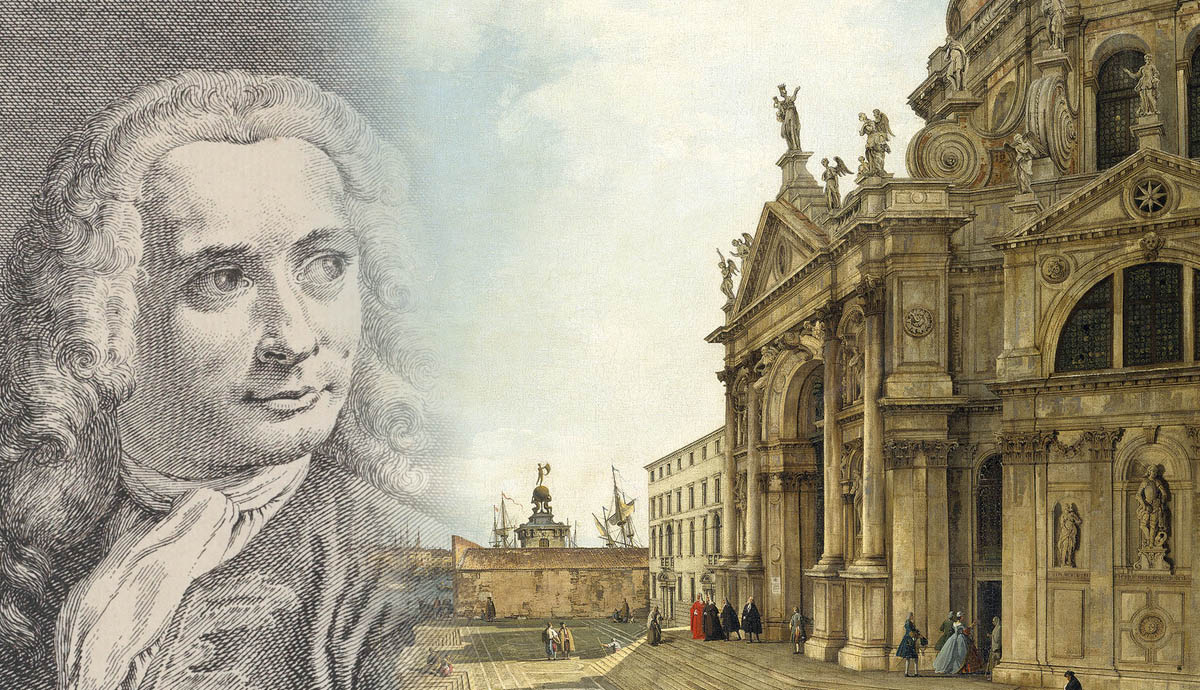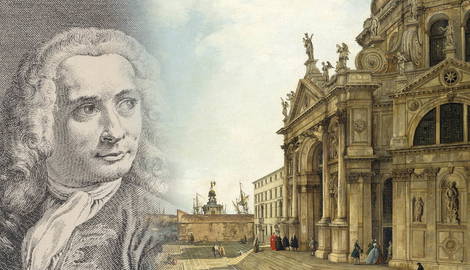
During the 18th century, the decline of the Most Serene Republic of Venice was palpable. The Republic, a leading European power since the Middle Ages, had lost part of its strength and glory. The city slowly declined, until the fall of the Venetian Republic to the armies of French ruler Napoleon Bonaparte, in 1797. However, while its political power diminished, the city’s social and cultural life prospered. One artist, in particular, captured the lively city’s atmosphere and gives us a glimpse into 18th-century Venice: Canaletto.
Canaletto’s Beginnings as a Theatrical Scene Painter

Giovanni Antonio Canal was born in 1697, near San Lio church in the Rialto Bridge neighborhood. The man who is now best known as Canaletto, meaning “little canal,” was the son of a renowned theatrical scene painter, Bernardo Canal, and he followed in his father’s footsteps. In the early years of his artistic career, Antonio and his brother Cristoforo were in charge of painting the decor for Fortunato Chelleri’s and Antonio Vivaldi’s operas.
In 1719, Antonio and his father traveled to Rome to design the decor for two operas composed by Alessandro Scarlatti. This trip played a crucial role in Antonio’s artistic career as he saw the work of some of the first vedute painters: Giovanni Paolo Panini and Caspar van Wittel. The latter, a Dutch painter working in Rome, took the Italianized name Gaspar Vanvitelli. Upon his return to Venice, Antonio changed his artistic orientation and started painting what he is now most famous for: vedute paintings.
Canaletto, Master of Vedute Painting

During the 18th century, a Northern painting tradition extensively influenced Venetian artists. Cityscape painting inspired by 17th-century Dutch artists flourished in Venice. This genre is also known as veduta (plural vedute), the Italian for “view”.
Painters of vedute, also known as vedutisti, meticulously depicted distinctive urban elements, and city landmarks, making them immediately recognizable. They had to master the strict rules of perspective to achieve a coherent whole. Vedutisti required the staging of the monuments of a city as if they were part of a theater set. Using light and shadows, they emphasized certain elements, sometimes exaggerating the proportions of specific buildings. Vedute painting and scenography both developed during the 18th century and influenced each other.

Canaletto created his vedute as miniature theater stages, depicting comic or dramatic scenes of everyday Venetian life. In the Capriccio view of the Courtyard of the Palazzo Ducale with the Scala dei Giganti, the scene is set in an eminent spot of Venetian life: the Doge’s Palace, housing the city’s seat of power. The Republic’s supreme authority, the Doge of Venice, had legislative, executive, and judicial powers. The courtyard of the Doge’s Palace, famous for its Giants’ Staircase, or Scala dei Giganti in Italian, is flanked by two colossal statues of Mars and Neptune, and it was the heart of Venice’s political life. In this painting, both eminent Venetian personalities and simple folk gather in the courtyard, offering a lively depiction of the city.
Even if it started as a traditional genre of Dutch painting, Venice quickly became the capital of vedute painting. Besides Canaletto, the most famous representatives of the vedutisti were Bernardo Bellotto, Francesco Guardi, and the Dutch painter Johannes Vermeer.
Venice: A Key Stop in the Grand Tour

During the 18th century, Venice was at the forefront of European artistic production. The city hosted several influential artists such as Baroque composer Antonio Vivaldi, Rococo painter Giovanni Battista Tiepolo, and Rococo sculptor Antonio Corradini. Famous castrati like Farinelli performed on Venice’s opera stages.
The artistic scene was not the only appeal of Venice. The carnival, the city’s most famous celebration, lasted for months. Moreover, other events provided Venetians with never-ending festivities. It was as though the Most Serene Republic of Venice’s political and economic descent would never happen.
With its exuberant activity and moral freedom, the famous La Serenissima was still fascinating. It attracted tourists from all over the continent. Indeed, the 18th century in Europe was also a century of travel. Since the mid-17th century, artists and well-bred young men had been partaking in Grand Tours: trips across the old continent to discover its cultural wonders and enhance their education. With its outstanding classical heritage, Italy was a key stop on this journey. Venice, a cosmopolitan and flamboyant city, particularly appealed to visitors.

British aristocrats were Canaletto’s prime clients. They appreciated contemplating the city’s landmarks and the sites of its most popular and traditional celebrations. His paintings reminded them of the time they had spent in Venice.
Among them was Joseph Smith, the British consul in Venice and a keen art collector and trader. Smith commissioned numerous vedute from Canaletto and sold them to tourists or brought them back to England. With the clear waters of the Venetian Lagoon and the city’s remarkable architecture, Canaletto’s work immediately appealed to tourists looking for souvenirs to bring back from their stay in Venice.
During the 1740s, British tourists disappeared from Venice because of the War of the Austrian Succession. The Republic of Venice and England were on opposite sides. Smith encouraged Canaletto to go to London, and the painter did so in 1746 and stayed there for several years. While in England, Canaletto painted many vedute of different parts of London, including Westminster Bridge, which was still under construction.
Piazza San Marco, One of Canaletto’s Favorite Views

Canaletto made hundreds of paintings and drawings depicting different views of Venice. Among his favorite subjects were views of the clear waters of the Grand Canal and the Piazza San Marco, the heart of Venice. As Canaletto often painted the same view several times, it is now easy to compare them and notice the changes in his technique.
Approximately a dozen years separate the above and below paintings of the Piazza San Marco. Yet, his technique changed dramatically. In the older depiction of Piazza San Marco, dating to around 1723, the dark parts of the cloudy sky and the buildings’ shadows give a more dramatic aspect to the scene. It is also pretty realistic, undoubtedly close to what the place looked like during Canaletto’s time. The awnings are not in the best of state – some are askew, and others ripped. The square’s pavement looks dirty, a normal state for an 18th-century city.

The other depiction of the Piazza San Marco, painted around 1730, looks far more like an idealized view of Venice. The colors appear brighter, and the minutely painted details give a perfect illustration of the city. The awnings are all aligned, and the elegant pavements are clearly visible. This kind of view certainly appealed more to British tourists looking for a souvenir to bring back home. Furthermore, while Canaletto used to paint on large canvases, he started using smaller canvases to suit the taste of the British public.
Canaletto and the Camera Obscura

The public especially admired the tiny details depicted in Canaletto’s vedute. Before the invention of photography, duplicating a cityscape’s exact shapes, perspectives, and dimensions was challenging. Painters had to master the technique of perspective. A particular device helped them draw precisely the outlines of a city’s monuments: the camera obscura.
A camera obscura, first a small room, then a simple box, is a dark space with a tiny hole on one side. The rays of light reflected by the surfaces of every surrounding object enter the camera obscura through a hole and project a reversed, inverted image of these objects on a plane and clear surface. As the device evolved, lenses and mirrors were added to gain precision. Among other uses, artists utilized the camera obscura as a drawing aid.

Canaletto had a portable camera obscura and he used it during his wanderings through the city. But he was well aware of the drawbacks of relying on such a tool. A camera obscura only helped; the artist needed to show his talent as well. Canaletto also made on-the-spot sketches and used them in addition to the drawings he produced using the camera obscura to compose his paintings.
Canaletto’s Reality: Venice Through the Painter’s Eyes

As we have already seen with the vedute paintings of Piazza San Marco, Canaletto’s cityscapes were not always strictly realistic. The painter did not hesitate to change the perspective or the buildings’ sizes to fit better a painting’s composition. In his Campo Santi Giovanni e Paolo, Canaletto accentuated the Gothic church’s grandeur by adding some theatrical effects. Tiny figures walk by, giving the monument full scale. Canaletto also enlarged the dome’s dimensions, while the sharp outline of the buildings’ shadows, though not realistic, added to the scene’s dramatic impact.

The Bacino di San Marco is another example of Canaletto’s perceived reality. The perspective shows that the painter is looking downwards at where the Giudecca Canal and the Grand Canal meet, probably from the Punta Della Dogana. Yet, the Church of San Giorgio Maggiore is not facing in the right direction. He changed its orientation so that the church was facing him. Canaletto juxtaposed several views of the same place, broadening the field of view over the San Marco basin.

In his work, Canaletto interpreted reality, giving us his vision of 18th-century Venice. Looking at his work is like seeing La Serenissima through the painter’s eyes. With an ability to render the city’s bright atmosphere through touches of colors and light in the tiniest details, Canaletto certainly was the most famous Venetian vedutisti. Along with his nephew, Bernardo Bellotto, and Francesco Guardi, the vedutisti offered lively depictions of the city that once was at the center of Europe’s cultural life.










